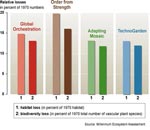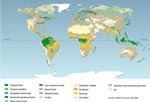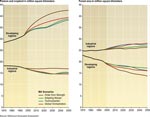


Four plausible scenarios explore the future of biodiversity and human well-being for the next 50 years and beyond. Under all of them, biodiversity loss is projected to continue extremely quickly over the next 50 years. Though the loss cannot be halted over this time period, it can be slowed down through better ecosystem protection, restoration, and management. More...
The four plausible scenarios explored in this assessment consider two possible paths of world development: increasing globalization or increasing regionalization. The scenarios also consider two different approaches to environmental issues: in one approach, actions are reactive and address problems only after they become obvious, in the other approach, ecosystem management is proactive and deliberately aims for long-term maintenance of ecosystem services.
The four scenarios are:
Further information about each scenario is provided in the links below:
| World Development | |||
| globalization | regionalization | ||
| Ecosystem Management | reactive |
 Global Orchestration |
 Order from Strength |
|---|---|---|---|
| proactive |
 TechnoGarden |
 Adapting Mosaic | |



On land, according to all four scenarios, the expansion of agriculture, cities, and infrastructure, will cause habitat loss and lead to a continuing decline in the local and global biodiversity. The habitat loss between 1970 and 2050, will lead to the extinction of approximately 10-15% of the species in the long term (depending on the scenario). Losses of habitat and plant populations will be fastest in warm mixed forests, savannas, scrub, as well as tropical forests and woodlands.
More proactive approaches to the environment (TechnoGarden and Adapting Mosaic) will have more success in slowing terrestrial habitat and biodiversity loss in the near future than reactive approaches. The scenario most concerned with security and protection (Order from Strength) has the highest rate of biodiversity loss.
In general, developing countries will experience an expansion of their agricultural lands and a reduction of their forest cover (a 30% loss between 1970 and 2050). Although the reverse is expected to happen in industrial countries, the result will be a net loss of forest.
Overall, biodiversity loss will be driven by land use change to a greater extent than by climate change and excessive nutrient levels, but the impact of these drivers will be different in different ecological communities (biomes). Other factors such as overharvesting, invasive species, and pollution will also speed up biodiversity loss. More...
Vast changes are expected in world freshwater resources including freshwater habitats, fish production, and water supply. Reactive approaches to environmental problems (as in the Order from Strength and Global Orchestration scenarios) will lead to a more severe decline than proactive approaches.
Fish populations are projected to be lost from some river basins due to the combined effects of climate change and water withdrawals. Other significant drivers of freshwater biodiversity loss include eutrophication, acidification, and increased invasions by alien species. Freshwater systems that are projected to have the greatest biodiversity loss are rivers of poor tropical and sub-tropical countries.
According to the scenarios, the demand for fish and the risk of a major long-lasting collapse of fisheries will increase because of the human population, incomes, and preferences for fish are increasing. More...
5.4.1 Biodiversity loss will lead to a deterioration of the benefits that humans obtain from ecosystems. It will increase the likelihood of ecological surprises, such as rapid climate change, desertification, fisheries collapse, floods, landslides, wildfires, eutrophication, and disease. The vulnerability of human well-being to these adverse surprises is different in each scenario but it is greatest in "Order from Strength". Such changes will affect human well-being directly but also indirectly, for instance because of conflicts due to scarcer food and water resources.
Scenarios with a proactive approach that limits deforestation (Adapting Mosaic and TechnoGarden) are more successful in preserving the regulation of ecosystem processes . Deforestation combined with climate change will increasingly lead to flooding during storms, but also to fires during droughts, greatly increasing the risk of even greater climate change. Deforestation will also reduce the capacity of terrestrial ecosystems to absorb carbon (carbon sequestration).
During this century, global temperature may increase by 2.0 to 3.5°C, depending on the scenario (note on differences compared to IPCC projections). Moreover, precipitation may increase over most of the land area on Earth, though some arid regions may become even more arid and sea levels will rise. According to the scenarios, changes in ecosystem services will be particularly rapid, in "hot spot regions" such as sub-Saharan Africa, the Middle East and Northern Africa, and South Asia.
While the average GDP per person improves in all scenarios, this can mask increased inequity for instance in terms of food security. More...
5.4.2 The scenarios indicate that many environmental and development goals are interdependent. Therefore, partnerships and international environmental agreements are important and vary greatly from one scenario to another. Major decisions in the next 50-100 years will have to address trade-offs between agricultural production and water quality, land use and biodiversity, water use and aquatic biodiversity, current water use for irrigation and future agricultural production, and in fact all current and future use of nonrenewable resources.
For a given level of socioeconomic development, policies that conserve more biodiversity will also promote higher overall human well-being by preserving various ecosystem services. In order to anticipate unexpected shifts in ecosystems, policies can diversify the ecosystem services used in a particular region, choose reversible actions, monitor changes in ecosystems, and adjust as new knowledge about upcoming changes becomes available. More...

This summary is free and ad-free, as is all of our content. You can help us remain free and independant as well as to develop new ways to communicate science by becoming a Patron!